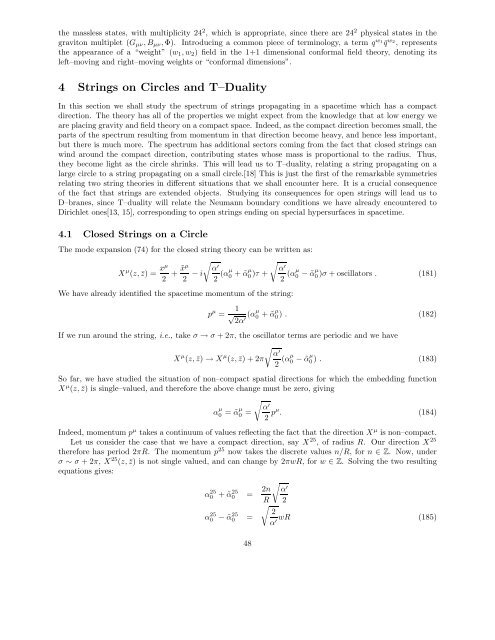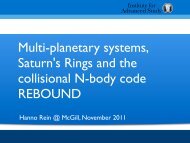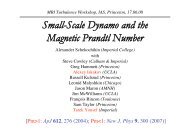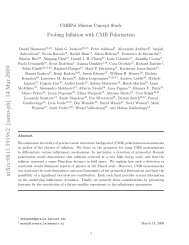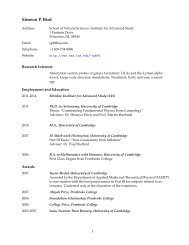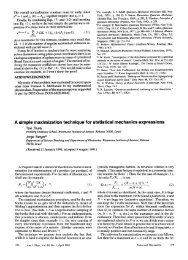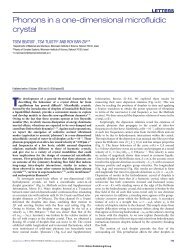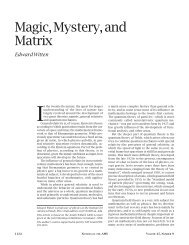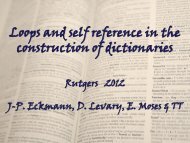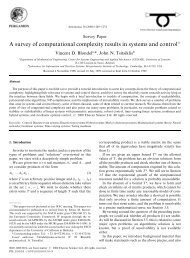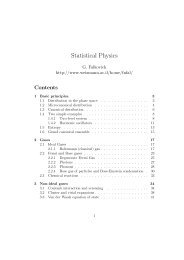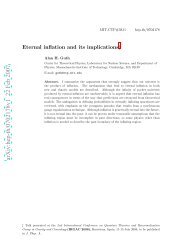Introduction to String Theory and D–Branes - School of Natural ...
Introduction to String Theory and D–Branes - School of Natural ...
Introduction to String Theory and D–Branes - School of Natural ...
Create successful ePaper yourself
Turn your PDF publications into a flip-book with our unique Google optimized e-Paper software.
the massless states, with multiplicity 24 2 , which is appropriate, since there are 24 2 physical states in the<br />
gravi<strong>to</strong>n multiplet (Gµν, Bµν, Φ). Introducing a common piece <strong>of</strong> terminology, a term q w1 ¯q w2 , represents<br />
the appearance <strong>of</strong> a “weight” (w1, w2) field in the 1+1 dimensional conformal field theory, denoting its<br />
left–moving <strong>and</strong> right–moving weights or “conformal dimensions”.<br />
4 <strong>String</strong>s on Circles <strong>and</strong> T–Duality<br />
In this section we shall study the spectrum <strong>of</strong> strings propagating in a spacetime which has a compact<br />
direction. The theory has all <strong>of</strong> the properties we might expect from the knowledge that at low energy we<br />
are placing gravity <strong>and</strong> field theory on a compact space. Indeed, as the compact direction becomes small, the<br />
parts <strong>of</strong> the spectrum resulting from momentum in that direction become heavy, <strong>and</strong> hence less important,<br />
but there is much more. The spectrum has additional sec<strong>to</strong>rs coming from the fact that closed strings can<br />
wind around the compact direction, contributing states whose mass is proportional <strong>to</strong> the radius. Thus,<br />
they become light as the circle shrinks. This will lead us <strong>to</strong> T–duality, relating a string propagating on a<br />
large circle <strong>to</strong> a string propagating on a small circle.[18] This is just the first <strong>of</strong> the remarkable symmetries<br />
relating two string theories in different situations that we shall encounter here. It is a crucial consequence<br />
<strong>of</strong> the fact that strings are extended objects. Studying its consequences for open strings will lead us <strong>to</strong><br />
D–branes, since T–duality will relate the Neumann boundary conditions we have already encountered <strong>to</strong><br />
Dirichlet ones[13, 15], corresponding <strong>to</strong> open strings ending on special hypersurfaces in spacetime.<br />
4.1 Closed <strong>String</strong>s on a Circle<br />
The mode expansion (74) for the closed string theory can be written as:<br />
X µ (z, ¯z) = xµ<br />
<br />
˜xµ α ′<br />
+ − i<br />
2 2 2 (αµ<br />
<br />
α ′<br />
0 + ˜αµ 0 )τ +<br />
2 (αµ 0 − ˜αµ 0 )σ + oscilla<strong>to</strong>rs . (181)<br />
We have already identified the spacetime momentum <strong>of</strong> the string:<br />
p µ = 1<br />
√ 2α ′ (αµ<br />
0<br />
+ ˜αµ 0 ) . (182)<br />
If we run around the string, i.e., take σ → σ + 2π, the oscilla<strong>to</strong>r terms are periodic <strong>and</strong> we have<br />
X µ (z, ¯z) → X µ <br />
α ′<br />
(z, ¯z) + 2π<br />
2 (αµ 0 − ˜αµ 0 ) . (183)<br />
So far, we have studied the situation <strong>of</strong> non–compact spatial directions for which the embedding function<br />
X µ (z, ¯z) is single–valued, <strong>and</strong> therefore the above change must be zero, giving<br />
α µ<br />
0 = ˜αµ 0 =<br />
<br />
α ′<br />
2 pµ . (184)<br />
Indeed, momentum p µ takes a continuum <strong>of</strong> values reflecting the fact that the direction X µ is non–compact.<br />
Let us consider the case that we have a compact direction, say X 25 , <strong>of</strong> radius R. Our direction X 25<br />
therefore has period 2πR. The momentum p 25 now takes the discrete values n/R, for n ∈ Z. Now, under<br />
σ ∼ σ + 2π, X 25 (z, ¯z) is not single valued, <strong>and</strong> can change by 2πwR, for w ∈ Z. Solving the two resulting<br />
equations gives:<br />
α 25<br />
0 + ˜α 25<br />
0 = 2n<br />
α 25<br />
0<br />
− ˜α25<br />
0 =<br />
48<br />
R<br />
α ′<br />
2<br />
<br />
2<br />
wR (185)<br />
α ′


